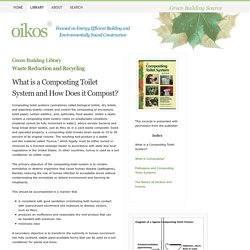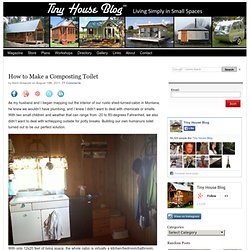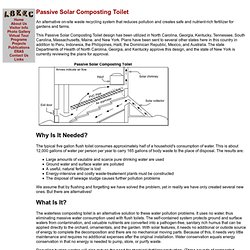

Composting Toilet Systems - Oikos. Green Building Library Waste Reduction and Recycling Composting toilet systems (sometimes called biological toilets, dry toilets and waterless toilets) contain and control the composting of excrement, toilet paper, carbon additive, and, optionally, food wastes.

Unlike a septic system a composting toilet system relies on unsaturated conditions (material cannot be fully immersed in water), where aerobic bacteria and fungi break down wastes, just as they do in a yard waste composter. Sized and operated properly, a composting toilet breaks down waste to 10 to 30 percent of its original volume. The resulting end-product is a stable soil-like material called "humus," which legally must be either buried or removed by a licensed seepage hauler in accordance with state and local regulations in the United States. In other countries, humus is used as a soil conditioner on edible crops.
Composting Toilets. Composting toilets are simple, low-tech, waterless toilets.

They are designed to provide favorable habitat for biological agents of decomposition such as bacteria, mold and fungi which break down feces and urine into compost. This miraculously transformative process encourages us to move beyond the concept of mere "waste disposal". It opens an opportunity to use our own compost to grow food for ourselves and thus to close the nutrient cycle. As such, using composting toilets can be a step toward relearning our place in the natural order. We have been using composting toilets since 1990, using the resulting compost to grow a variety of edible plants. Since most aspects of composting toilets including design, use, legalities, etc. are addressed in the several books listed at the end of this section, I will cover them only briefly here. Our Current Composting Toilet and Graywater System.
-Barrel Composting Toilet For the past 5 years we have been developing a composting toilet design that is simple, inexpensive and easy to replicate, yet also meets most of the design considerations addressed on our Composting Toilet Regulations page.

The system is constructed of 5 gallon buckets and 55 gallon plastic barrels. Most of the materials can be purchased at a hardware store and the cost of the system is about $250. The system features vector control, zero leachate discharge to native soil, aeration and moisture control of the compost and construction of durable, non-corrosive materials. Although the system is designed for use in mild climates, we've used it in places as diverse as Arizona and Oregon. This system requires occasionally emptying buckets containing fecal matter and is therefore not for the fecophobic.
Variation on Our Current Composting Toilet System. How to Make a Composting Toilet. As my husband and I began mapping out the interior of our rustic shed-turned-cabin in Montana, he knew we wouldn’t have plumbing, and I knew I didn’t want to deal with chemicals or smells.

With two small children and weather that can range from -20 to 85-degrees Fahrenheit, we also didn’t want to deal with schlepping outside for potty breaks. Building our own humanure toilet turned out to be our perfect solution. With only 12x20 feet of living space, the whole cabin is virtually a kitchen/bedroom/bathroom. We had to choose between putting the loo by the hot stove (not safe for children) by the hide-a-bed, or in this quiet corner. While some question the cleanliness of pooping so close to a food prep area, one must remember that this is not a flushing toilet that sprays bacteria into the air with every flush.
We get quite a few jokes from friends and family about our “lovey loo,” but I would take our lovely-loo over a honey bucket any day! LBEEC: Passive Solar Composting Toilet. An alternative on-site waste recycling system that reduces pollution and creates safe and nutrient-rich fertilizer for gardens and farms.

This Passive Solar Composting Toilet design has been utilized in North Carolina, Georgia, Kentucky, Tennessee, South Carolina, Massachusetts, Maine, and New York. Plans have been sent to several other states here in this country in addition to Peru, Indonesia, the Philippines, Haiti, the Dominican Republic, Mexico, and Australia. The state Departments of Health of North Carolina, Georgia, and Kentucky approve this design, and the state of New York is currently reviewing the plans for approval.
Why Is It Needed? The typical five gallon flush toilet consumes approximately half of a household's consumption of water. What Is It? The waterless composting toilet is an alternative solution to these water pollution problems. Recycling human wastes will also reduce the need for chemical fertilizer production. How Does It Work? Where Can They Be Applied? Solar Composting Toilet - Dunton Farms. This is one of those important projects that took a long time to reach the top of the project list.

It is too inconvenient to be working in the barnyard or fields and run up to the house whenever the situation arises. Additionally, we were just not set up to accommodate visitors. Our goal is to eventually open the farm to the public and now we have a toilet facility. We had this project listed on the Victory Seed Web site in 2004 as a future need. Natural Building Resources: The Sunny John Moldering Toilet. Sunny Johns.